Rooibos
Rooibos (/ˈrɔɪbɒs/ ROY-boss; Afrikaans: [rɔːibɔs]; Aspalathus linearis), meaning 'red bush'; is a broom-like member of the plant family Fabaceae that grows in South Africa's fynbos.
| Rooibos Aspalathus linearis | |
|---|---|
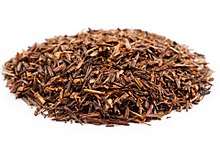 | |
| Prepared rooibos | |
| Scientific classification | |
| Kingdom: | |
| (unranked): | |
| (unranked): | |
| (unranked): | |
| Order: | |
| Family: | |
| Subfamily: | |
| Tribe: | |
| Genus: | |
| Species: | A. linearis |
| Binomial name | |
| Aspalathus linearis | |
.jpg)
The leaves are used to make a herbal tea that is called by the names: rooibos (especially in Southern Africa), bush tea, red tea, or redbush tea (predominantly in Great Britain), and sometimes rooibosch in accordance with the Dutch for 'red bush'.
The tea has been popular in Southern Africa for generations, and since the 2000s has gained popularity internationally. The tea has a taste and color somewhat similar to hibiscus tea, with more or less of an earthy flavor like yerba mate.
Rooibos was formerly classified as Psoralea but is now thought to be part of Aspalathus following Dahlgren (1980). The specific name of linearis was given by Burman (1759) for the plant's linear growing structure and needle-like leaves.
Production and processing
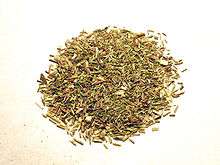
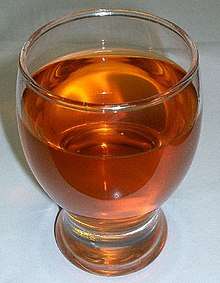
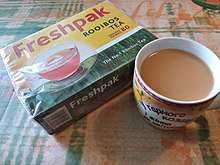
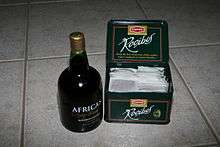
Rooibos is usually grown in the Cederberg, a small mountainous area in the region of the Western Cape province of South Africa.[2]
Generally, the leaves undergo an oxidation (often termed "fermentation" in common tea processing terminology). This process produces the distinctive reddish-brown colour of rooibos and enhances the flavour. Unoxidised "green" rooibos is also produced, but the more demanding production process for green rooibos (similar to the method by which green tea is produced) makes it more expensive than traditional rooibos. It carries a malty and slightly grassy flavour somewhat different from its red counterpart.[3]
Use
Rooibos tea is commonly prepared in the same manner as black tea, usually without or with a little milk, and/or sugar or honey. Other methods include a slice of lemon and using honey instead of sugar to sweeten. It is also served as espresso, lattes, cappuccinos or iced tea.[4]
Chemical composition
As a fresh leaf, rooibos contains a high content of ascorbic acid (vitamin C),[5] which is lost when made into tea.
Rooibos tea does not contain caffeine[6][7] and has low tannin levels compared to black tea or green tea.[5] Rooibos contains polyphenols, including flavanols, flavones, flavanones, dihydrochalcones,[8][9] aspalathin[10] and nothofagin.[11]
The processed leaves and stems contain benzoic and cinnamic acids.[12]
Grading
Rooibos grades are largely related to the percentage "needle" or leaf to stem content in the mix. A higher leaf content results in a darker liquor, richer flavour and less "dusty" aftertaste. The high-grade rooibos is exported and does not reach local markets, with major consumers being the EU, particularly Germany, where it is used in creating flavoured blends for loose-leaf tea markets.
History
Three species of the Borboniae group of Aspalathus, namely A. angustifolia, A. cordata and A. crenata, were once used as tea. These plants have simple, rigid, spine-tipped leaves, hence the common name 'stekeltee'. The earliest record of the use of Aspalathus as a source of tea was that of Carl Peter Thunberg, who wrote about the use of A. cordata as tea: "Of the leaves of Borbonia cordata the country people make tea" (Thunberg, July 1772, at Paarl). This anecdote is sometimes erroneously associated with rooibos tea (Aspalathus linearis).[13]
Archaeological record suggests that the Aspalathus linearis could have been utilised by humans many thousands of years ago. Although the indigenous pastoralists and hunter-gatherers could have used this plant, it does not imply that they made the beverage we know as rooibos tea in precolonial times.[14] The traditional method of harvesting and processing rooibos (for making rooibos infusion or decoction tea) could have, at least partly, originated in precolonial times. However, it does not necessarily follow that San and Khoikhoi utilised this method to prepare a beverage that they consumed for pleasure, as tea.
The earliest available ethnobotanical records of rooibos tea originate in the late 19th century. No Khoi or San vernacular names of the species have been recorded. Several authors have assumed that the tea originated from the local inhabitants of the Cederberg. Apparently, rooibos tea is a traditional drink of Khoi-descended people of the Cederberg (and "poor whites"). However, this tradition has not been traced further back than the last quarter of the 19th century.[13]
Traditionally, the local people would climb the mountains and cut the fine, needle-like leaves from wild rooibos plants. They then rolled the bunches of leaves into hessian bags and brought them down the steep slopes using donkeys. Rooibos tea was traditionally processed by beating the material on a flat rock with a heavy wooden pole or club or a large wooden hammer.[13]
The historical record of rooibos uses in precolonial and early colonial times is mostly a record of absence. Colonial-era settlers could have learnt about some properties of the Aspalathus linearis from pastoralists and hunter-gatherers of the Cederberg region. The nature of that knowledge was not documented. Given the available data, the origin of rooibos tea can be viewed in the context of the global expansion of tea trade and the colonial habit of drinking Chinese and later Ceylon tea. In this case, the rooibos infusion or decoction served as a local replacement for the expensive Asian product.[14]
It appears that both the indigenous (San and Khoikhoi) and the colonial inhabitants of rooibos-growing areas contributed to the traditional knowledge of rooibos in some way. For instance, medicinal uses might have been introduced before the eighteenth century, by Khoisan pastoralists or San hunter-gatherers. And the utilisation of the Aspalathus linearis for making tea, including the production processes, such as bruising and oxidising the leaves, are more likely to have been introduced in colonial times, by settlers accustomed to drinking Asian tea or its substitutes.[14]
In 1904, Benjamin Ginsberg ran a variety of experiments at Rondegat Farm, finally curing rooibos. He simulated the traditional Chinese method of making Keemun by fermenting the tea in barrels. The major hurdle in growing rooibos commercially was that farmers could not germinate the rooibos seeds. The seeds were hard to find and impossible to germinate commercially. Medical doctor by profession and business partner to Ginsberg, Pieter Lafras Nortier ascertained that seeds require a process of scarification before planting in acidic, sandy soil.[15][16]
By the late 1920s, growing demand for the tea led to problems with supply of the wild rooibos plants. As a remedy, Dr Pieter Lefras Nortier, district surgeon in Clanwilliam and avid naturalist, proposed to develop a cultivated variety of rooibos to be raised on appropriately situated land. Nortier worked on cultivation of the rooibos species in partnership with farmers Oloff Bergh and William Riordan, and with encouragement from Benjamin Ginsberg.[14]
Bergh harvested a large amount of rooibos in 1925 on his farm Kleinvlei, in the Pakhuis Mountains. Dr Nortier collected seeds in the Pakhuis Mountains (Rocklands) and in a large valley called Grootkloof and these first selected seeds are known as the Nortier-type and Redtea-type.[17]
In 1930 Nortier began conducting experiments with the commercial cultivation of the rooibos plant. Dr Nortier cultivated the first plants at Clanwilliam on his farm Eastside and on the farm Klein Kliphuis. The tiny seeds were very difficult to come by. Dr Nortier paid the local villagers £5 per matchbox of seeds collected. An aged Khoi woman found an unusual seed source: having chanced upon ants dragging seed, she followed them back to their nest and, on breaking it open, found a granary.[18]
Dr. Nortier's research was ultimately successful and he subsequently showed all the local farmers how to germinate their own seeds. The secret lay in scarifying the seed pods. Dr Nortier placed a layer of seeds between two mill stones and ground away some of the seed pod wall. Thereafter the seeds were easily propagated. Over the next decade the price of seeds rose to £80/pound, the most expensive vegetable seed in the world, as farmers rushed to plant rooibos. Today, the seed is gathered by special sifting processes. Dr Nortier is today accepted as the father of the rooibos tea industry.
The variety developed by Nortier has become the mainstay of the rooibos industry enabling it to expand and create income and jobs for inhabitants of rooibos-growing regions.[14] Thanks to Nortier's research, rooibos tea became an iconic national beverage and then a globalised commodity. Rooibos tea production is today the economic mainstay of the Clanwilliam district. In 1948 The University of Stellenbosch awarded Dr Nortier an Honorary Doctorate D.Sc (Agria) in recognition for his valuable contribution to South African agriculture.
US trademark controversy
In 1994, Burke International registered the name "Rooibos" with the US Patent and Trademark Office, thus establishing a monopoly on the name in the United States at a time when it was virtually unknown there. When the plant later entered more widespread use, Burke demanded that companies either pay fees for use of the name, or cease its use. In 2005, the American Herbal Products Association and a number of import companies succeeded in defeating the trademark through petitions and lawsuits; after losing one of the cases, Burke surrendered the name to the public domain.[19]
Legal protection of the name rooibos
The South African Department of Trade and Industry issued final rules on 6 September 2013 that protects and restricts the use of the names "rooibos", "red bush", "rooibostee", "rooibos tea", "rooitee" and "rooibosch" in that country, so that the name cannot be used for things not derived from the Aspalathus linearis plant. It also provides guidance and restrictions for how products which include rooibos, and in what measures, should use the name "rooibos" in their branding.[20]
Threat from climate change
The rooibos plant is endemic to a small part of the western coast of the Western Cape province of South Africa. It grows in a symbiotic relationship with local micro-organisms. A 2012 South African news items cited the concerns of one Willem Engelbrecht of Groenkol Rooibos Tea Estate regarding the prospects of rooibos farming in the face of climate change.[21]
See also
References
- "Aspalathus linearis (Burm.f.) R.Dahlgren". International Legume Database & Information Service (ILDIS). Retrieved 6 May 2016 – via The Plant List.
- Muofhe, M.L.; Dakora, F.D. (1999). "Nitrogen nutrition in nodulated field plants of the shrub tea legume Aspalathus linearis assessed using 15N natural abundance". Plant and Soil. 209 (2): 181–186. doi:10.1023/A:1004514303787.
- Standley, L; Winterton, P; Marnewick, JL; Gelderblom, WC; Joubert, E; Britz, TJ (January 2001). "Influence of processing stages on antimutagenic and antioxidant potentials of rooibos tea". Journal of Agricultural and Food Chemistry. 49 (1): 114–7. doi:10.1021/jf000802d. PMID 11170567.
- "Rooibos tea cappuccino or latte - Cape Point Press". Cape Point Press. 6 March 2014. Retrieved 20 July 2017.
- Morton, Julia F. (1983). "Rooibos tea, aspalathus linearis, a caffeineless, low-tannin beverage". Economic Botany. 37 (2): 164–73. doi:10.1007/BF02858780. JSTOR 4254477.
- Iswaldi, I; Arráez-Román, D; Rodríguez-Medina, I; Beltrán-Debón, R; Joven, J; Segura-Carretero, A; Fernández-Gutiérrez, A (2011). "Identification of phenolic compounds in aqueous and ethanolic rooibos extracts (Aspalathus linearis) by HPLC-ESI-MS (TOF/IT)". Analytical and Bioanalytical Chemistry. 400 (10): 3643–54. doi:10.1007/s00216-011-4998-z. PMID 21509483.
- Stander, Maria A.; Joubert, Elizabeth; De Beer, Dalene (2019). "Revisiting the caffeine-free status of rooibos and honeybush herbal teas using specific MRM and high resolution LC-MS methods". Journal of Food Composition and Analysis. Elsevier BV. 76: 39–43. doi:10.1016/j.jfca.2018.12.002. ISSN 0889-1575.CS1 maint: ref=harv (link)
- Krafczyk, Nicole; Woyand, Franziska; Glomb, Marcus A. (2009). "Structure-antioxidant relationship of flavonoids from fermented rooibos". Molecular Nutrition & Food Research. 53 (5): 635–42. doi:10.1002/mnfr.200800117. PMID 19156714.
- Bramati, Lorenzo (2002). "Quantitative Characterization of Flavonoid Compounds in Rooibos Tea ( Aspalathus linearis ) by LC−UV/DAD". Journal of Agricultural and Food Chemistry. 50: 5513–5519. doi:10.1021/jf025697h. PMID 12236672.
- Ku, S. K.; Kwak, S; Kim, Y; Bae, J. S. (2015). "Aspalathin and Nothofagin from Rooibos (Aspalathus linearis) inhibits high glucose-induced inflammation in vitro and in vivo". Inflammation. 38 (1): 445–55. doi:10.1007/s10753-014-0049-1. PMID 25338943.
- Joubert, E. (1996). "HPLC quantification of the dihydrochalcones, aspalathin and nothofagin in rooibos tea (Aspalathus linearis) as affected by processing". Food Chemistry. 55 (4): 403–411. doi:10.1016/0308-8146(95)00166-2.
- Rabe, C; Steenkamp, JA; Joubert, E; Burger, JF; Ferreira, D (1994). "Phenolic metabolites from rooibos tea (Aspalathus linearis)". Phytochemistry. 35 (6): 1559–1565. doi:10.1016/S0031-9422(00)86894-6.
- Van Wyk, B.-E.; Gorelik, B (2017). "The history and ethnobotany of Cape herbal teas". South African Journal of Botany. 110: 20–28. doi:10.1016/j.sajb.2016.11.011. Retrieved 12 November 2019.
- Gorelik, Boris (October 2018). "Rooibos: an ethnographic perspective" (PDF). South African Rooibos Council. Retrieved 12 November 2019.
- "Aspalathus linearis | PlantZAfrica". pza.sanbi.org. Retrieved 15 January 2020.
- Stander, M. A.; Brendler, T.; Redelinghuys, H.; Van Wyk, B. -E. (1 March 2019). "The commercial history of Cape herbal teas and the analysis of phenolic compounds in historic teas from a depository of 1933". Journal of Food Composition and Analysis. 76: 66–73. doi:10.1016/j.jfca.2018.11.001. ISSN 0889-1575.
- Van Putten, JW (2000). Die Geskiedenis van Rooibos. Clanwilliam: JW van Putten. pp. 5–12.
- Green, Lawrence (1949). In The Land of the Afternoon. Standard Press Ltd. pp. 52–54.
- "Rooibos Trademark Abandoned". American Herbal Products Association.
- "Merchandise Marks Act, 1941 (Act 17 of 1941), Final Prohibition on the Use of Certain Words]" (PDF). Department of Trade and Industry, Republic of South Africa. 6 September 2013. Retrieved 20 December 2014.
- "Climate change threatens rooibos". News24, IAB South Africa. 27 February 2012. Retrieved 27 April 2013.
External links
